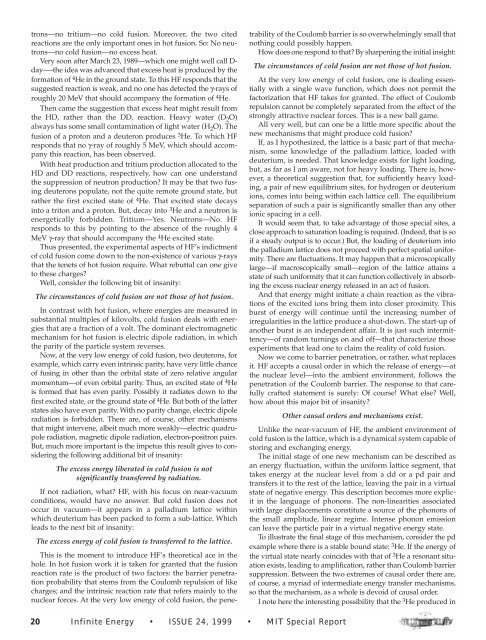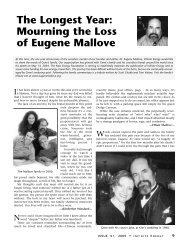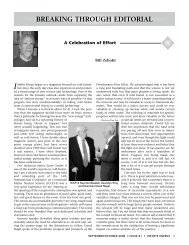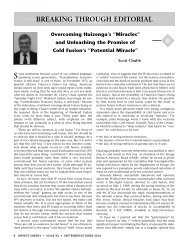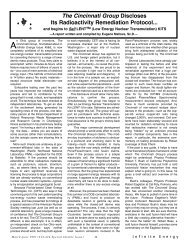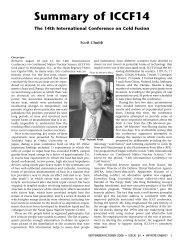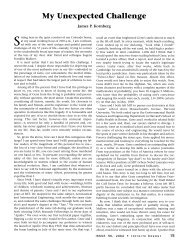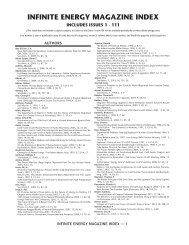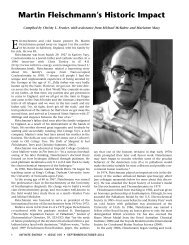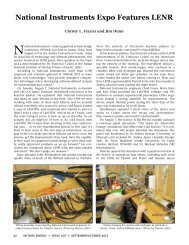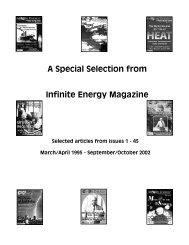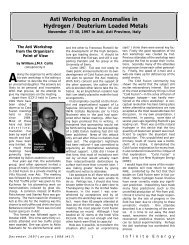MIT and Cold Fusion: A Special Report - Infinite Energy Magazine
MIT and Cold Fusion: A Special Report - Infinite Energy Magazine
MIT and Cold Fusion: A Special Report - Infinite Energy Magazine
Create successful ePaper yourself
Turn your PDF publications into a flip-book with our unique Google optimized e-Paper software.
trons—no tritium—no cold fusion. Moreover, the two cited<br />
reactions are the only important ones in hot fusion. So: No neutrons—no<br />
cold fusion—no excess heat.<br />
Very soon after March 23, 1989—which one might well call D-<br />
day—-the idea was advanced that excess heat is produced by the<br />
formation of 4 He in the ground state. To this HF responds that the<br />
suggested reaction is weak, <strong>and</strong> no one has detected the γ-rays of<br />
roughly 20 MeV that should accompany the formation of 4 He.<br />
Then came the suggestion that excess heat might result from<br />
the HD, rather than the DD, reaction. Heavy water (D 2 O)<br />
always has some small contamination of light water (H 2 O). The<br />
fusion of a proton <strong>and</strong> a deuteron produces 3 He. To which HF<br />
responds that no γ-ray of roughly 5 MeV, which should accompany<br />
this reaction, has been observed.<br />
With heat production <strong>and</strong> tritium production allocated to the<br />
HD <strong>and</strong> DD reactions, respectively, how can one underst<strong>and</strong><br />
the suppression of neutron production? It may be that two fusing<br />
deuterons populate, not the quite remote ground state, but<br />
rather the first excited state of 4 He. That excited state decays<br />
into a triton <strong>and</strong> a proton. But, decay into 3 He <strong>and</strong> a neutron is<br />
energetically forbidden. Tritium—Yes. Neutrons—No. HF<br />
responds to this by pointing to the absence of the roughly 4<br />
MeV γ-ray that should accompany the 4 He excited state.<br />
Thus presented, the experimental aspects of HF’s indictment<br />
of cold fusion come down to the non-existence of various γ-rays<br />
that the tenets of hot fusion require. What rebuttal can one give<br />
to these charges?<br />
Well, consider the following bit of insanity:<br />
The circumstances of cold fusion are not those of hot fusion.<br />
In contrast with hot fusion, where energies are measured in<br />
substantial multiples of kilovolts, cold fusion deals with energies<br />
that are a fraction of a volt. The dominant electromagnetic<br />
mechanism for hot fusion is electric dipole radiation, in which<br />
the parity of the particle system reverses.<br />
Now, at the very low energy of cold fusion, two deuterons, for<br />
example, which carry even intrinsic parity, have very little chance<br />
of fusing in other than the orbital state of zero relative angular<br />
momentum—of even orbital parity. Thus, an excited state of 4 He<br />
is formed that has even parity. Possibly it radiates down to the<br />
first excited state, or the ground state of 4 He. But both of the latter<br />
states also have even parity. With no parity change, electric dipole<br />
radiation is forbidden. There are, of course, other mechanisms<br />
that might intervene, albeit much more weakly—electric quadrupole<br />
radiation, magnetic dipole radiation, electron-positron pairs.<br />
But, much more important is the impetus this result gives to considering<br />
the following additional bit of insanity:<br />
The excess energy liberated in cold fusion is not<br />
significantly transferred by radiation.<br />
If not radiation, what? HF, with his focus on near-vacuum<br />
conditions, would have no answer. But cold fusion does not<br />
occur in vacuum—it appears in a palladium lattice within<br />
which deuterium has been packed to form a sub-lattice. Which<br />
leads to the next bit of insanity:<br />
The excess energy of cold fusion is transferred to the lattice.<br />
This is the moment to introduce HF’s theoretical ace in the<br />
hole. In hot fusion work it is taken for granted that the fusion<br />
reaction rate is the product of two factors: the barrier penetration<br />
probability that stems from the Coulomb repulsion of like<br />
charges; <strong>and</strong> the intrinsic reaction rate that refers mainly to the<br />
nuclear forces. At the very low energy of cold fusion, the penetrability<br />
of the Coulomb barrier is so overwhelmingly small that<br />
nothing could possibly happen.<br />
How does one respond to that? By sharpening the initial insight:<br />
The circumstances of cold fusion are not those of hot fusion.<br />
At the very low energy of cold fusion, one is dealing essentially<br />
with a single wave function, which does not permit the<br />
factorization that HF takes for granted. The effect of Coulomb<br />
repulsion cannot be completely separated from the effect of the<br />
strongly attractive nuclear forces. This is a new ball game.<br />
All very well, but can one be a little more specific about the<br />
new mechanisms that might produce cold fusion?<br />
If, as I hypothesized, the lattice is a basic part of that mechanism,<br />
some knowledge of the palladium lattice, loaded with<br />
deuterium, is needed. That knowledge exists for light loading,<br />
but, as far as I am aware, not for heavy loading. There is, however,<br />
a theoretical suggestion that, for sufficiently heavy loading,<br />
a pair of new equilibrium sites, for hydrogen or deuterium<br />
ions, comes into being within each lattice cell. The equilibrium<br />
separation of such a pair is significantly smaller than any other<br />
ionic spacing in a cell.<br />
It would seem that, to take advantage of those special sites, a<br />
close approach to saturation loading is required. (Indeed, that is so<br />
if a steady output is to occur.) But, the loading of deuterium into<br />
the palladium lattice does not proceed with perfect spatial uniformity.<br />
There are fluctuations. It may happen that a microscopically<br />
large—if macroscopically small—region of the lattice attains a<br />
state of such uniformity that it can function collectively in absorbing<br />
the excess nuclear energy released in an act of fusion.<br />
And that energy might initiate a chain reaction as the vibrations<br />
of the excited ions bring them into closer proximity. This<br />
burst of energy will continue until the increasing number of<br />
irregularities in the lattice produce a shut-down. The start-up of<br />
another burst is an independent affair. It is just such intermittency—of<br />
r<strong>and</strong>om turnings on <strong>and</strong> off—that characterize those<br />
experiments that lead one to claim the reality of cold fusion.<br />
Now we come to barrier penetration, or rather, what replaces<br />
it. HF accepts a causal order in which the release of energy—at<br />
the nuclear level—into the ambient environment, follows the<br />
penetration of the Coulomb barrier. The response to that carefully<br />
crafted statement is surely: Of course! What else? Well,<br />
how about this major bit of insanity?<br />
Other causal orders <strong>and</strong> mechanisms exist.<br />
Unlike the near-vacuum of HF, the ambient environment of<br />
cold fusion is the lattice, which is a dynamical system capable of<br />
storing <strong>and</strong> exchanging energy.<br />
The initial stage of one new mechanism can be described as<br />
an energy fluctuation, within the uniform lattice segment, that<br />
takes energy at the nuclear level from a dd or a pd pair <strong>and</strong><br />
transfers it to the rest of the lattice, leaving the pair in a virtual<br />
state of negative energy. This description becomes more explicit<br />
in the language of phonons. The non-linearities associated<br />
with large displacements constitute a source of the phonons of<br />
the small amplitude, linear regime. Intense phonon emission<br />
can leave the particle pair in a virtual negative energy state.<br />
To illustrate the final stage of this mechanism, consider the pd<br />
example where there is a stable bound state: 3 He. If the energy of<br />
the virtual state nearly coincides with that of 3 He a resonant situation<br />
exists, leading to amplification, rather than Coulomb barrier<br />
suppression. Between the two extremes of causal order there are,<br />
of course, a myriad of intermediate energy transfer mechanisms,<br />
so that the mechanism, as a whole is devoid of causal order.<br />
I note here the interesting possibility that the 3 He produced in<br />
20 <strong>Infinite</strong> <strong>Energy</strong> • ISSUE 24, 1999 • <strong>MIT</strong> <strong>Special</strong> <strong>Report</strong>


